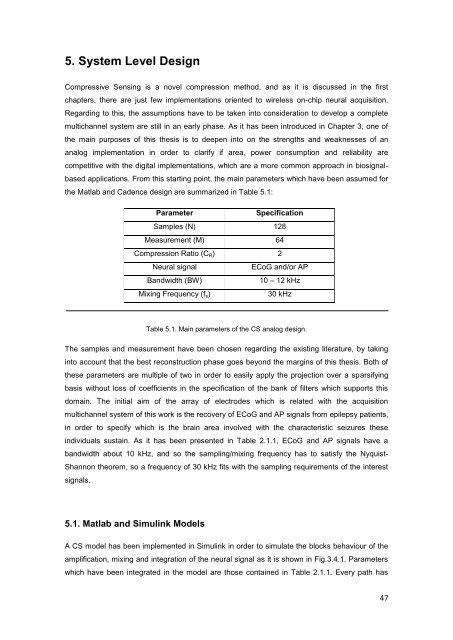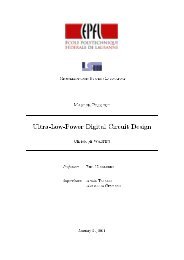Compressive Sensing system for recording of ECoG signals in-vivo
Compressive Sensing system for recording of ECoG signals in-vivo
Compressive Sensing system for recording of ECoG signals in-vivo
You also want an ePaper? Increase the reach of your titles
YUMPU automatically turns print PDFs into web optimized ePapers that Google loves.
5. System Level Design<strong>Compressive</strong> <strong>Sens<strong>in</strong>g</strong> is a novel compression method, and as it is discussed <strong>in</strong> the firstchapters, there are just few implementations oriented to wireless on-chip neural acquisition.Regard<strong>in</strong>g to this, the assumptions have to be taken <strong>in</strong>to consideration to develop a completemultichannel <strong>system</strong> are still <strong>in</strong> an early phase. As it has been <strong>in</strong>troduced <strong>in</strong> Chapter 3, one <strong>of</strong>the ma<strong>in</strong> purposes <strong>of</strong> this thesis is to deepen <strong>in</strong>to on the strengths and weaknesses <strong>of</strong> ananalog implementation <strong>in</strong> order to clarify if area, power consumption and reliability arecompetitive with the digital implementations, which are a more common approach <strong>in</strong> biosignalbasedapplications. From this start<strong>in</strong>g po<strong>in</strong>t, the ma<strong>in</strong> parameters which have been assumed <strong>for</strong>the Matlab and Cadence design are summarized <strong>in</strong> Table 5.1:ParameterSpecificationSamples (N) 128Measurement (M) 64Compression Ratio (C R ) 2Neural signal<strong>ECoG</strong> and/or APBandwidth (BW)10 – 12 kHzMix<strong>in</strong>g Frequency (f s )30 kHzTable 5.1. Ma<strong>in</strong> parameters <strong>of</strong> the CS analog design.The samples and measurement have been chosen regard<strong>in</strong>g the exist<strong>in</strong>g literature, by tak<strong>in</strong>g<strong>in</strong>to account that the best reconstruction phase goes beyond the marg<strong>in</strong>s <strong>of</strong> this thesis. Both <strong>of</strong>these parameters are multiple <strong>of</strong> two <strong>in</strong> order to easily apply the projection over a sparsify<strong>in</strong>gbasis without loss <strong>of</strong> coefficients <strong>in</strong> the specification <strong>of</strong> the bank <strong>of</strong> filters which supports thisdoma<strong>in</strong>. The <strong>in</strong>itial aim <strong>of</strong> the array <strong>of</strong> electrodes which is related with the acquisitionmultichannel <strong>system</strong> <strong>of</strong> this work is the recovery <strong>of</strong> <strong>ECoG</strong> and AP <strong>signals</strong> from epilepsy patients,<strong>in</strong> order to specify which is the bra<strong>in</strong> area <strong>in</strong>volved with the characteristic seizures these<strong>in</strong>dividuals susta<strong>in</strong>. As it has been presented <strong>in</strong> Table 2.1.1, <strong>ECoG</strong> and AP <strong>signals</strong> have abandwidth about 10 kHz, and so the sampl<strong>in</strong>g/mix<strong>in</strong>g frequency has to satisfy the Nyquist-Shannon theorem, so a frequency <strong>of</strong> 30 kHz fits with the sampl<strong>in</strong>g requirements <strong>of</strong> the <strong>in</strong>terest<strong>signals</strong>.5.1. Matlab and Simul<strong>in</strong>k ModelsA CS model has been implemented <strong>in</strong> Simul<strong>in</strong>k <strong>in</strong> order to simulate the blocks behaviour <strong>of</strong> theamplification, mix<strong>in</strong>g and <strong>in</strong>tegration <strong>of</strong> the neural signal as it is shown <strong>in</strong> Fig.3.4.1. Parameterswhich have been <strong>in</strong>tegrated <strong>in</strong> the model are those conta<strong>in</strong>ed <strong>in</strong> Table 2.1.1. Every path has47















